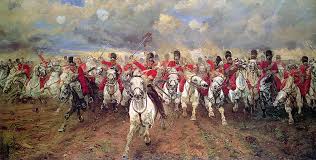Imagine living in the 1800s and having to worry about whether your money will still be worth something tomorrow. That was a real concern for many people! Before the gold standard, countries used all sorts of money—gold, silver, and even random paper currencies. Exchange rates fluctuated like crazy, and international trade was a mess.
Then, one by one, countries started realizing:
💡 “Hey, Britain is doing really well with this gold-backed currency. Maybe we should try it too?”
And just like that, a global movement toward the gold standard began. Over the next few decades, major economies—including Germany, the U.S., France, Japan, and many others—made the switch. By the early 1900s, gold-backed money wasn’t just a British thing; it had become the foundation of the world’s financial system.

Why Did So Many Countries Choose Gold?
1. Britain Was Leading the Way
- Britain was the world’s biggest trading power, and its economy was thriving under the gold standard.
- If you wanted to trade with Britain (which most countries did), it made sense to adopt the same system to avoid currency headaches.
2. People Wanted Stable Money
- In the past, some governments printed too much paper money, causing inflation and financial chaos.
- Gold-backed money meant that every banknote had real value, because you could exchange it for gold anytime.
3. International Trade Became Easier
- With multiple countries using gold, exchange rates became stable—no more wild currency swings!
- This made global trade and investment much smoother, boosting economic growth.
✅ Result: More and more countries jumped on the gold bandwagon, believing it would bring them financial stability and stronger economies.
Germany’s Big Gold Move (1871–1873)
Germany’s shift to the gold standard was all about timing and war money.
- In 1871, Germany won the Franco-Prussian War, forcing France to pay a massive war indemnity (5 billion francs—yep, that’s a lot).
- The German government used this gold to completely ditch its old silver-based currency and introduce the gold-backed mark in 1873.
This was a game-changer. Germany was one of the biggest economies in Europe, and when it switched to gold, other countries started reconsidering their silver-based systems.
✅ Result: Germany’s move accelerated Europe’s transition to gold and pushed silver-based currencies closer to extinction.
The U.S. and the “Gold vs. Silver” Debate (1873–1900)
America’s path to the gold standard was… well, messy. Unlike Germany, which made a clean break, the U.S. spent decades arguing about whether to stick with silver or go full gold.
- 1873: The U.S. passed the Coinage Act, quietly ending the free coinage of silver. Critics later called this “The Crime of 1873” because it hurt farmers and debtors who relied on silver money.
- 1896: The debate heated up with the famous “Cross of Gold” speech, where William Jennings Bryan passionately argued for keeping silver.
- 1900: The Gold Standard Act was passed, officially tying the U.S. dollar to gold.
✅ Result: The U.S. was finally on a solid gold foundation, making the dollar more trustworthy worldwide.
More Countries Jump In (1870s–1900s)
France & the Latin Monetary Union (1878)
- France had been using both gold and silver (a system called bimetallism), but after Germany switched to gold, they felt pressure to follow.
- By 1878, France, Belgium, Switzerland, and Italy had all transitioned to gold, forming the Latin Monetary Union.
Japan’s Gold Moment (1897)
- Japan was originally on a silver standard, but this made trade with Western nations tricky.
- After winning the First Sino-Japanese War (1894–1895), Japan received a huge war indemnity from China (paid in silver).
- Japan converted the silver to gold and officially adopted the gold standard in 1897, making the yen more competitive internationally.
✅ Result: By the turn of the century, most major economies were using gold, creating a unified global financial system.
How the Gold Standard Actually Worked
So, now that all these countries were using gold-backed money, what did that mean in practice? Here’s how it worked:
✔ Fixed Exchange Rates: Each country set a fixed value for its currency in gold, making exchange rates stable and predictable.
✔ Paper Money = Gold: You could walk into a bank and exchange paper notes for gold anytime (as long as the bank had enough gold reserves!).
✔ Gold Flows & Trade Adjustments: If a country imported too much and lost gold, the money supply would shrink, slowing down spending and correcting the imbalance.
✅ Result: This system kept inflation low, made trade easier, and gave people confidence in their money.
The Gold Standard Wasn’t Perfect
While the gold standard brought stability, it also had some serious drawbacks:
⚠️ Deflation Problems: If gold supplies didn’t grow fast enough, economies could suffer from falling prices and slower growth.
⚠️ Gold Supply Dependency: Countries were limited by how much gold they had—if they ran low, their economies could suddenly contract.
⚠️ No Flexibility in a Crisis: Unlike today, where central banks can adjust interest rates, gold-backed economies had less room to react to economic downturns.
✅ Result: It worked great when times were good, but in a crisis, it could make things worse—something that would become painfully obvious in the years ahead.
Wrapping It Up: Gold Becomes the Global Standard
By the early 1900s, the gold standard had officially taken over the world. Countries that adopted it:
✅ Had stable economies and attracted more investment.
✅ Benefited from easier and safer international trade.
✅ Kept inflation under control by preventing reckless money printing.
But while gold brought stability, it also tied economies to a rigid system—one that wouldn’t handle major shocks well.f economic growth, it also had inherent weaknesses, particularly its dependence on gold supply and lack of flexibility. These limitations would later cause problems during economic crises and wartime shocks.
